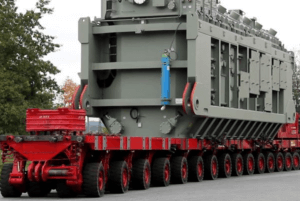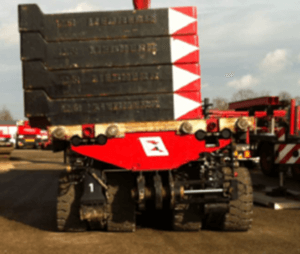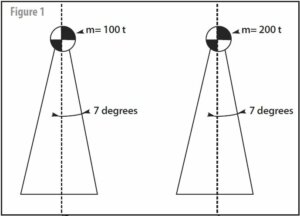
Stability of SPMTs: common practice and safety
There is no standard formula for determining the stability of self-propelled modular transporters (SPMTs). Instead, it is calculated using a common rule of thumb based on practical experience.
This rule is quite simple: if the tipping angle is lower than the theoretical minimum tipping angle, the transport will be safe. The minimum tipping angle that is most commonly used is 7 degrees.
What is remarkable, is that not everyone is aware of the fact that these rules of thumb are affected by the elasticity of the complete transport. For example, in Figure 1 the transport is simplified to a mass positioned on a triangular construction that has a top angle of 14 degrees. The transport will tip if it encounters a camber of 7 degrees, irrespective of the mass of the transport.
In the next example, the influence of elasticity is illustrated by means of the springs underneath the transporter. It is unclear what camber this transporter can drive without tipping. It is clear, however, that the mass of the transport plays an important role now. The transport on the right (200 tons) will tip earlier than the one on the left (100 tons), simply due to the influence of elasticity. In addition to this, it is very clear that both transports will tip far earlier than at 7 degrees. If the elasticity is infinitely weak (theoretically), the load tips at 0 degrees.
Calculations Stability of SPMTs
The purpose of this article is not to suggest that the current rules are useless. They have been used for decades and are based on practical experience. The minimum tipping angle of 7 degrees is supposed to cover most transports and a variety of elasticities.
On the other hand, we must be honest with ourselves: accidents still happen even with transports that meet the requirements of the commonly used rules. In some cases it is human failure, and in others the cause remains a blind spot.
What can be done? Special calculation tools allow the determination of the elasticity of a transport. With this in mind, the deflections of the transport can be calculated. In this way, the safety of the transport can be guaranteed by on-the-job calculation of the behavior of the combination. But how can we recognize when special treatment is needed?
Calculating deflections
Theoretically, the only way to know whether a move needs special attention concerning stability is by calculating deflections. There are several factors that can dramatically increase deflections during an SPMT transport operation:
- The number of lines. In most situations when using SPMTs two or more lines wide, the elasticity is low enough to use the common rules of thumb. The main picture shows a single-line trailer.

- Floating SPMT trailers. The ‘roll stiffness’ of a barge can increase the overall elasticity of the transport. It is necessary to pay special attention to the metacentric height and mass of the barge.
- SPMT trailers driving on ramps. It is essential to consider the properties of any ramps used in the transport, as their rigidity/flexibility will influence the total elasticity of the transport.

- Hydraulic layout. Besides the fact that the stability of a three-point hydraulic layout is lower than that of a four-point layout, the elasticity is also much higher. This last aspect should sound a warning, especially in combination with other ‘stiffness killers’ like ro-ro ramps or barges. The actual ‘roll-elasticity’ of a trailer (including hydraulic layout) can be measured, as shown above right.

All in all, the quantification of elasticity is the common factor in lift operations and in SPMT operations; therefore special attention concerning stability is necessary.
The content of this article is intended to provide a general guide to the subject matter. Please contact us for specialist advice about your specific circumstances.
This article was also published in HLPFI magazine.
WANT TO LEARN EVEN MORE ABOUT SPMT TRANSPORT STABILITY?
In the past years we have written or contributed to a range of articles and videos about SPMTs and transport stability. Click on the links below to read them:
- Calculating how to ensure transport stability
- Trailer Stability: The AST rule
- Lift stability and transport stability: Determining Elasticity
- Maintaining stability
- Webinar: Basic principles of SPMT transport stability
- Online Video: Stability of SPMT transport | 3-4 point suspensions explained
Upcoming events
What we do
As an independent partner, we advise about, design and construct everything from concept study to project completed. Our in-house developed design software calculates everything concerning mobile cranes and bespoke heavy equipment, while our people offer the expertise and skills that secure your success.
GET YOUR PROJECT PREPARED
Consultancy / Design & Construction
Our 40 years of experience provides the basis of a successful start of your project: right from the FEED phase. Preparation is vital. Therefore our concept studies, method statements and mission equipment offer you all the support you need.
GET YOUR PROJECT EXECUTION SUPPORTED
Consultancy / Design & Construction
Our aim is to optimize your project team’s results. With our exclusive knowledge of lifting and transportation we eliminate and manage risks. This is how we reach our collective goal: Zero Accidents, Zero Incidents.
DESIGN OF LIFTING & TRANSPORT ASSETS
Engineering
We have built up a great deal of experience with the design of (mobile) cranes and bespoke heavy equipment such as piling machines and excavators. Our customer base includes the most prominent producers of cranes and heavy machinery worldwide.
We are eager to hear from you
Call +31 (0) 30 240 80 60 or use the contact form. We always respond within 24 hours.

